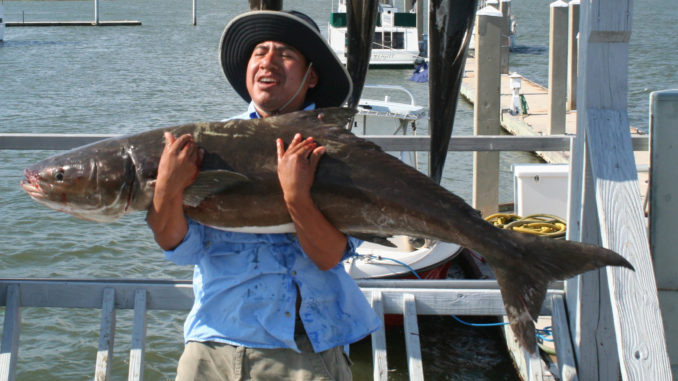
Arrival of “everyman’s gamefish”stirs anglers
Many anglers choose to keep their excursions down to a minimum during the colder months. Cold and South Carolina don’t necessarily go well together, so when spring returns, eager saltwater fishermen are not far behind it.
While anglers migrate toward the coast, another creature is migrating in from offshore waters to nearshore reefs, inshore rivers and sounds: the cobia. The arrival of cobia is undoubtedly one of the most anticipated events in the Lowcountry. The first fish start showing up inshore in April, and some will hang around well into June.
Nearshore reefs, including the Betsy Ross off Hilton Head, will usually hold a few fish as early as March and as late as August. It’s the fish that come inshore to places like the Broad River that cause the most excitement because it’s an opportunity for anglers in smaller vessels not suited for offshore travel to get a shot at a really big, hard-fighting fish — some in excess of 75 pounds. Truly, cobia are the “every-man’s” big gamefish.
Dropping a baited hook anywhere inshore while cobia are around can produce, but some areas are more productive than others. Capt. Brian Vaughn of Off the Hook Charters in Hilton Head likes to target particular features.
“Cobia tend to ambush prey as it comes over the shallow sandbars, and they also like to hang on ledges in channels where depth can range from shallow to deep quickly,” he said.
The reason fishing these areas produces cobia is simple; cobia hold in slower current and wait for food to come to them. There are many ledges, channels, sandbars and other current breaks throughout sounds and rivers that are easily discovered using even the most basic sonar, and they all have potential to hold numerous fish.
Crossing the SC 170 bridge over the Broad River would lead many people to believe that the only place cobia are found is near the bridge itself, due in part to the fact that the bridge has been a traditional area to catch cobia for many years because of many of the aforementioned features, but literally dozens of other places are nearby; the fishing is just as good but a lot less crowded. A little searching before dropping anchor goes a long way when numerous neighbors are not desired. Another option is to avoid the Broad River altogether and head for either the St. Helena or Calibogue sounds.
“As long as there is a broad entrance to the ocean like the Calibogue has and a good influx of baitfish, there should be plenty of cobia migrating in just like they do in the Port Royal Sound and Broad River,” Vaughn said.
Fishing baits on the bottom is the most-popular method for taking cobia, and any larger-profile live bait will work. Stomach-content studies conducted by the S.C. Department of Natural Resources at many cobia tournaments have found a myriad of different food sources, from blue and stone crabs to whole stingrays, puffer fish, mullet, herring and many other creatures. Favorite baits for cobia are live herring and menhaden, either caught on a Sabiki rig or netted, and live eels carried by many local bait or tackle shops. The main thing is for the bait to have a lot of movement and a fairly large profile, because even a small cobia has no problem fitting a big meal into its mouth.
Medium-heavy, 7-foot rods and reels are a good choice when fishing on the bottom. It can take as much as four ounces of weight on a jumbo Carolina rig to keep the bait down. Also, bigger baits and bigger fish require bigger hooks. Most guides recommend using 5/0 or 6/0 circle hooks with 40- to 60-pound mono or fluorocarbon leaders.
Another option for anglers who prefer to hunt for fish instead of wait on them is to motor around slowly and search for cobia near the surface. Especially during the slack time just before and after a tidal change, cobia like to cruise near the surface in search of food. Not easily spooked, boats can usually pull within 30 feet of a cruising cobia or even closer and cast a bait or lure, like a Zara Spook, directly into its path, resulting in an often visually exciting hook-up. This is also a time when fly anglers have an opportunity to test their skills against one of the hardest-fighting fish willing to eat a fly.
Capt. Tuck Scott of Bay Street Outfitters in Beaufort recommends throwing larger, flashier flies, with big eyes and a 3/0 to 4/0 hook for cobia.
“You have to strip a fly very fast to get a cobia’s attention and create a reaction strike, and brighter bigger flies can make that happen,” he said.
One thing for certain, cobia are on the way. It’s time to get the boat ship-shape, the rods ready, stock up on sunscreen, and be ready to welcome them back home, because —Hallelujah! — it’s spring.




Be the first to comment